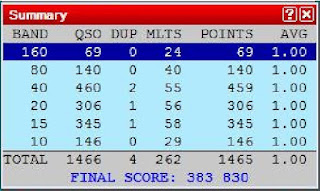 |
| The RCFORB radio control software |
It's been several years since I last participated in the CQP 160 meter contest. It doesn't make sense for me to make the 10 hour drive to Fallbrook to operate what is essentially a night-time only contest, even though two nights are involved. In order to participate, the OPs at NX6T enabled my remote access to STN #1 during the dinner hour and the post-midnight to sunrise periods. While I was able to make this work, the internet latency (especially during the dinner hour) was HORRIBLE.
 |
| No antenna tuner needed here |
 |
| The 160-m Inverted Vee @70' |
Equipment wise we ran a bevy of Elecraft K3's into an ACOM 2000 amplifier out to a 160 meter inverted vee 70' high at the apex. Remote facilities included Logmein-Hamachi, RCFORB & the VNC Viewer.
For the 2016 contest, the noise at the NX6T was an intrusive factor; largely S-8 on Friday evening.
While there are DNR noise filters in the Elecraft K-3 they are not easy to manipulate by way of the RCFORB remote radio software so I suffered through.
Then again, because this contest had no 40 meter operation, I was spared the usual belches, VFO sweeps Russian beacons and phantom RTTY signals I usually have to slog through during the 10:00z to 12:00z time frame on 40 meters during most CW contests.
 |
| STN#1 during the dinner hour |
As sunrise made it's way I had made over 200 QSOs including a handful of countries thanks to a greyline-style opening to Asia Saturday morning just before the band faded into oblivion.
For Saturday evening, because the band opened "late" and the fact that we had worked a majority of stateside stations the pace started out slow. When I took over at 04:00z for the dinner hour the internet latency was at its worst, altho eventually settled down affording a nice frequency run on 1.848 (mhz).
After the operator change-back I took to the world of sleep.
Because my cellphone was on the charger while I slept I didn't hear the 20+ attempts by N6KI to roust me from my slumber. Eventually I rolled out of bed, fired up a middle-of-the-night Kona coffee and hit the couch. While the internet latency had settled down, there were not a lot of stations to work,
so at N6KI's recommendation I S&P'd for the 1st hour until I could find nothing left.
By 12:00z I was calling CQ on 1.802.76.
Sunday morning the signal strength of W6's & W7's nearly burned out the cheap headphones I was using. In retrospect I shoulda brought in my Heil headset from the trunk of my car, but I was too lazy to make the trip. (I own the Heil PRO headset with the phase-switch on the left ear).
Sunday morning did not produce the desired repeat of Saturday morning's greyline, so by 14:30z
I shutdown the remote connection and went back to bed - effectively ending the contest for us.
Despite the frustrating internet latency problems, overall, this was a fun CQ 160 contest; all of which could be run via a laptop on the living room coffee table. I recently upgraded my Toshiba laptop to a solid state disk drive, keeping Windows 7 rather than upgrade to Windoze 10.
As I have experienced recently, remote radio operations seem to run more smoothly with this configuration. Looking at the contest results from the 3830 Scores website it looks as tho we took 23rd place worldwide and quite likely 1st place for California.
 |
| The view from NX6T's Fallbrook location |
In the last 2 months I have been fortunate to join NX6T's Fallbrook operations remotely from a number of different locations on my part.
While the internet enables many amazing things in the 21st century I want to warn radio operators not to become overly reliant on an infrastructure that can be disrupted at any moment.
I still love sitting in front of a radio with knobs; tuning stations via a software screen is marginally effective, and, in the case of RTTY very tricky at best.
 |
| N6KI's formula for winning contests |
For me, next up operation-wise is February's ARRL Dx CW contest, which will most likely include 160 meter operations.
DiD YOU join in this year's CQ 160 contest?
Is NX6T in YOUR log?













